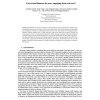7 search results - page 1 / 2 » Learning acceptable windows of contingency |
CONNECTION
2006
13 years 7 months ago
2006
By learning a range of possible times over which the effect of an action can take place, a robot can reason more effectively about causal and contingent relationships in the world...
HCI
2007
13 years 8 months ago
2007
: Emotional bonds don’t arise from a simple exchange of facial displays, but often emerge through the dynamic give and take of face-to-face interactions. This article explores th...
CHI
1996
ACM
13 years 11 months ago
1996
ACM
We show how to deliver a sophisticated, yet intuitive, interactive application over the web using off-the-shelf web browsers as the interaction medium. This attracts a large user ...
VR
1999
IEEE
13 years 11 months ago
1999
IEEE
The study of human-computer interaction within immersive virtual environments requires us to balance what we have learned from the design and use of desktop interfaces with novel ...
HRI
2007
ACM
13 years 11 months ago
2007
ACM
Effective human/robot interfaces which mimic how humans interact with one another could ultimately lead to robots being accepted in a wider domain of applications. We present a fr...



